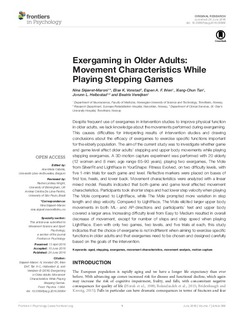| dc.contributor.author | Skjæret-Maroni, Nina | |
| dc.contributor.author | Vonstad, Elise | |
| dc.contributor.author | Ihlen, Espen Alexander F. | |
| dc.contributor.author | Tan, Xiang chun | |
| dc.contributor.author | Helbostad, Jorunn L. | |
| dc.contributor.author | Vereijken, Beatrix | |
| dc.date.accessioned | 2016-09-13T07:46:15Z | |
| dc.date.accessioned | 2016-09-16T12:09:07Z | |
| dc.date.available | 2016-09-13T07:46:15Z | |
| dc.date.available | 2016-09-16T12:09:07Z | |
| dc.date.issued | 2016 | |
| dc.identifier.citation | Frontiers in Psychology 2016 | nb_NO |
| dc.identifier.issn | 1664-1078 | |
| dc.identifier.uri | http://hdl.handle.net/11250/2407832 | |
| dc.description.abstract | Despite frequent use of exergames in intervention studies to improve physical function in older adults, we lack knowledge about the movements performed during exergaming. This causes difficulties for interpreting results of intervention studies and drawing conclusions about the efficacy of exergames to exercise specific functions important for the elderly population. The aim of the current study was to investigate whether game and game level affect older adults’ stepping and upper body movements while playing stepping exergames. A 3D-motion capture experiment was performed with 20 elderly (12 women and 8 men; age range 65–90 years), playing two exergames, The Mole from SilverFit and LightRace in YourShape: Fitness Evolved, on two difficulty levels, with
five 1-min trials for each game and level. Reflective markers were placed on bases of first toe, heels, and lower back. Movement characteristics were analyzed with a linear
mixed model. Results indicated that both game and game level affected movement characteristics. Participants took shorter steps and had lower step velocity when playing The Mole compared to LightRace, while The Mole prompted more variation in step length and step velocity. Compared to LightRace, The Mole elicited larger upper body movements in both ML- and AP-directions and participants’ feet and upper body covered a larger area. Increasing difficulty level from Easy to Medium resulted in overall decrease of movement, except for number of steps and step speed when playing
LightRace. Even with only two games, two levels, and five trials at each, this study indicates that the choice of exergame is not indifferent when aiming to exercise specific
functions in older adults and that exergames need to be chosen and designed carefully based on the goals of the intervention. | nb_NO |
| dc.language.iso | eng | nb_NO |
| dc.publisher | Frontiers Media | nb_NO |
| dc.rights | Navngivelse 3.0 Norge | * |
| dc.rights | Navngivelse 3.0 Norge | * |
| dc.rights.uri | http://creativecommons.org/licenses/by/3.0/no/ | * |
| dc.title | Exergaming in Older Adults: Movement Characteristics While Playing Stepping Games | nb_NO |
| dc.type | Journal article | nb_NO |
| dc.type | Peer reviewed | nb_NO |
| dc.date.updated | 2016-09-13T07:46:15Z | |
| dc.source.journal | Frontiers in Psychology | nb_NO |
| dc.identifier.doi | 10.3389/fpsyg.2016.00964 | |
| dc.identifier.cristin | 1380648 | |
| dc.description.localcode | © 2016 Skjæret-Maroni, Vonstad, Ihlen, Tan, Helbostad and Vereijken. This is an open-access article distributed under the terms of the Creative Commons Attribution License (CC BY). The use, distribution or reproduction in other forums is permitted, provided the original author(s) or licensor are credited and that the original publication in this journal is cited, in accordance with accepted academic practice. No use, distribution or reproduction is permitted which does not comply with these terms. | nb_NO |

